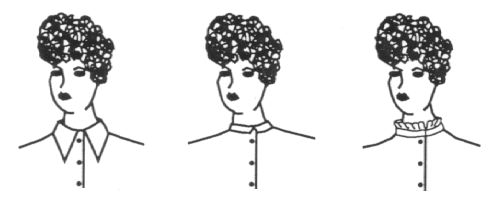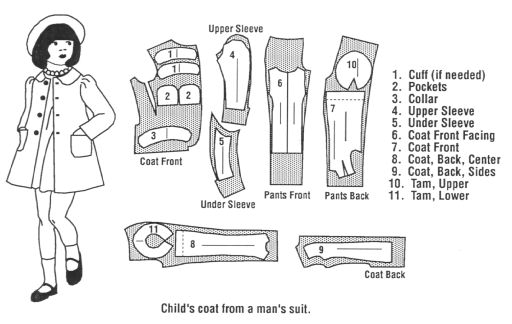Apparel Industry Fact Sheet from Ohio State
Recycling Clothing Using Your Sewing Skills
HYG-5504-91
Barbara H. DrakeIf you have sewing skills and have the use of a sewing machine, you can turn little- or never-used textile items into usable additions to your family's wardrobe or home. Some basic sewing skills are needed for repairing, changing or customizing a garment. More advanced skills are needed to remodel a garment or re-cut it for use by another family member. Before you start a recycling project, ask yourself the following questions:
- Is the fabric in good condition?
- Is the garment worth the time that will be involved?
- Do I have the patience to undertake the project?
- Is the garment design one that is suitable for recycling?
- Do I need the garment or will the person for whom it is planned wear it?
- Do I have the necessary sewing skills to make a professional looking garment?
- Will it save me money or will I be compensated because of a feeling of self-satisfaction?
Changing or Restyling
Trims and buttons embellish many expensive fashion items today. Use this to your advantage to enliven clothes that otherwise may be discarded. Save trims and buttons from unusable garments to embellish T-shirts, sweatshirts and jackets. Cluster different buttons at necklines or on pockets. Use a variety of laces and trims to cover holes, spots, worn areas or creases where garments have been lengthened. Combine laces, trims and fabric scraps in unusual ways. The more lavish, the better.
Saved buttons can also be used to replace buttons on a garment. Buttons down the front of a blouse should blend, but today's fashion look says they all don't have to match. An expensive white cotton blouse seen in a department store, sported eight different gold and rhinestone buttons and cost more than $100.
Hand stitch satin ribbon over the outside seams of slacks for a tuxedo pant look. This is especially pretty with black or grey slacks using matching or contrasting satin ribbon. Wear with a dressy white long-sleeved blouse for an instant evening look.
Utilize cotton ribbing, purchased in fabric stores, to give an active sportswear look to pant legs or jacket sleeves that are too short. Cut off at the hem edge and sew on the purchased ribbing.
Remove a worn convertible collar from a blouse by ripping out the stitching at the top of the collar band. Add lace trim and re-stitch. Stitching can also be removed from the cuff edge and the same lace inserted and re-sewn. Worn collars and cuffs can be removed and the old pieces used as patterns for new collars and cuffs of contrasting fabrics.

Full slips can be made into camisoles and mini slips. Cut off tops 2 inches to 4 inches below the waist. Hem edge or trim with lace. Insert elastic at the folded top edge of the bottom portion of the remodeled slip to make a mini slip to wear with shorter style skirts.
Sweaters can be quickly restyled, especially if you own a zigzag or serger sewing machine. Remove sleeves and turn under and stitch armholes to turn sweaters into vests. Turtlenecks can be cut down to crew necks. Pullover sweaters can be made into cardigans. Make two rows of machine stitching down the center front, then cut between them. Add grosgrain ribbon, buttons and buttonholes. Hints for restyling sweaters can be found in the Singer Reference Guide - Clothing Care & Repair.
Turn a dress into a blouse. Make sure you allow enough length at the bottom to tuck it into a skirt or slacks or wear it as an overblouse.
Pant legs can easily be made narrower. Follow these steps:
- Remove the hem,
- Mark the new stitching line, tapering the pants from the knee area, or above, to the hem, (make sure to remove the same amount of fabric from side seam and inseam areas),
- Re-stitch new seam lines, trimming seam allowances and rehem.
Change the Purpose of an Item
Think about how else an item can be used. For example, fabric rosettes, so popular as a woman's fashion accessory, can be made from a man's tie (see craft magazines and pattern books for instructions.)
An old fur stole can be made into a hat, collar or pillow covers.
Never-worn edges of mattress pads can find new life as hot pads, table runners, glasses cases, or padding and reinforcement for a number of items. Edges will need to be bound.
Old sheets can be made into garment bags for furs, wedding gowns or formals.
Children love to dress up. Can your clothes be given to a child for play?
Re-cutting Garments
Adult clothing can be a good source of fabric for a garment for another family member. Here are some ideas for things that can be made:
From a Dress
- A different dress for yourself or a child
- A blouse for yourself or a child
- A child's jumper or short set
- A boy's shirt
- A pair of shorts for yourself
- A top to wear with pants
From a Skirt
- A child's dress
- A child's skirt or play suit
- A child's coat or jacket if the skirt is heavy fabric
- A blouse or vest for yourself
From a Man's Suit
- A skirt for yourself
- A boy's or girl's suit
- A jumper for yourself or a child
- A child's coat or jacket
From a Coat
- A jacket for yourself
- A child's coat or jacket
- A jumper for yourself or a child
- A suit or two-piece dress for yourself
From a Man's Shirt
- A child's skirt or blouse
- A smock or apron
- A blouse for yourself
Prepare the fabric for re-cutting by either ripping all seams apart or if there is enough fabric, cutting along seam lines. Either have the fabric cleaned or carefully hand wash and press. Save all buttons, zipper and notions.
Lay pattern pieces out, paying close attention to grain lines and fabric direction if there is a nap or plaid or print. Now sew it by treating the fabric as if it were new.

Sources
Baker, Marjorie. New Clothes From Old, Oklahoma State University Cooperative Extension Service.
Foulds, Joyce. Fashion Economics, New Mexico State University Cooperative Extension Service.
Singer Reference Library, Clothing Care & Repair, Cy DeCrosse Inc., 1985.
Smith, Joyce & Pitts, Norma. Revitalize Your Wardrobe - Recycling Clothes for the Family, Teaching Outline, The Ohio State Cooperative Extension Service, June 1983.
Weiland, Barbara & Leslie Wood. Clothes Sense, Palmer/pletsch Associates, 1985.
Vanderpoorten, Margaret Ann. Ideas For Major Changes, Texas A&M University Cooperative Extension Service.
Also, see article on Recycling Clothing with No Sewing Skills Needed
Apparel Search
Add Your Company
Contact
Us About Us
Advertise
News Letter
Legal
Help
Copyright © 1999-2023 Apparel Search Company.
All Rights Reserved.